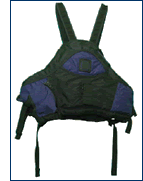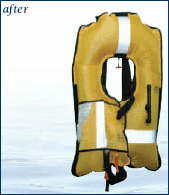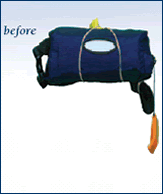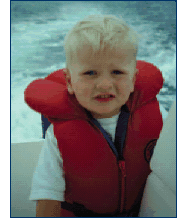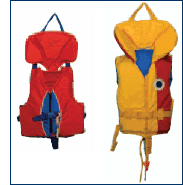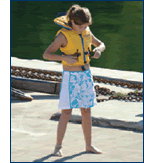You are required by law to have a lifejacket or PFD (personal flotation device) on board for each person on a watercraft, including human-powered crafts.
On this page
- Choosing a lifejacket
- Choosing a Personal Flotation Device (PFD)
- Keeping children afloat
- Approval to Canadian standards
- Care and use of your flotation device
- Cold water
- Flotation devices for hunters and anglers
- Flotation devices for stand-up paddleboarders
Choosing a lifejacket
Lifejackets provide more flotation in water than most PFDs. Lifejackets come only in red, orange, and yellow so you are more visible while in water.
There are three Canadian-approved types:
1. Safety of Life at Sea (SOLAS) lifejackets meet very high-performance standards and are approved for all vessels. They:
- turn you on your back in seconds to keep your face out of the water, even if you are unconscious
- come in two sizes — over 32 kg (70 lbs.) or less than 32 kg
- are available in comfortable and compact inflatable styles that can be automatically, manually, or orally inflated
2. Standard Type lifejackets are approved for all vessels, except SOLAS vessels. They:
- turn you on your back to keep your face out of the water, even if you are unconscious
- come in two sizes — over 40 kg (88 lbs.) or less than 40 kg
3. Small Vessel lifejackets are approved for small vessels. They:
- have less flotation than Standard Type lifejackets
- turn you on your back, but may do so more slowly
- come in two models — keyhole and vest
- come in three sizes
Choosing a Personal Flotation Device (PFD)
PFDs come in many types, sizes, and colours. Not all are red, orange, or yellow; but it is a good idea to choose these colours to be more visible when in water.
Choose a PFD based on your needs and your activity. If you are operating at high speeds, look for a PFD with three or more chest belts for security.
A PFD differs from lifejacket because:
- it may be more comfortable because it is designed for constant wear
- is lighter, less bulky, and may be designed for specific sport activities
- usually offers less flotation than a lifejacket
- has limited capability to turn you in the water
- usually offers less thermal protection than a lifejacket
- if inflatable, must be used and maintained correctly in order to work
If you choose an inflatable PFD , check which boating activities they are approved for under the Small Vessel Regulations. Inflatable PFDs are prohibited for:
- people who are under 16 years of age, or who weigh under 36.3 kg (80 lbs.)
- operators of personal watercraft
Inflatable PFDs come in two styles:
- Vest types inflate automatically, or are inflated orally or manually with a CO2 system.
- Pouch types can be orally inflated, or manually inflated by pulling a toggle to activate CO2 inflation.
The inflation time is relatively short but still could be difficult for a weak swimmer. All Canadian-approved inflatable PFDs have an oral inflation tube in case the CO2 inflation mechanism fails. If you are struggling to stay afloat, using this tube could be challenging.
An emergency is no time to experiment with a new device. Read your manual for the PFD carefully. Under supervision and before heading out, try the device on and make sure you know how to use it.
Keeping children safe on and around the water
A lifejacket or PFD is no substitute for adult supervision. Children should be within arm’s reach as well as wearing a proper flotation device at all times. It should fit snugly and not ride up over your child’s chin or ears. There should be less than 7.6 cm (3”) between your child’s shoulders and the device. Otherwise, the device is too big and could do more harm than good.
Look for these safety features:
- a large collar for head support
- waist ties or elastic gathers in front and back
- a safety strap that goes between the legs to prevent the device from slipping over your child's head
- buckles on safety straps and reflective tape
- Consider attaching a non-metallic pea-less whistle to the device.
Approval to Canadian standards
Look for a lifejacket or PFD with a label that says the device has been approved by any of the organizations below:
- Transport Canada
- Canadian Coast Guard
- Fisheries and Oceans Canada
Care and use of your flotation device
Treat your flotation device as an investment and take good care of it. Devices that are ripped or in poor condition are not considered approved.
Lifesaving equipment should never be kneeled on, sat on, or used as a fender for your boat. Follow these tips:
- Check its buoyancy regularly by wading out to waist-deep water and bending your knees to see how well you float.
- Ensure that straps, buckles, and zippers are clean and in good working order.
- Tug on straps to ensure they are well attached with no sign of wear.
- Dry your device in open air and avoid direct heat sources.
- Store it in a dry, well-ventilated, easily accessible place.
- Do not dry clean. Use mild soap and running water to clean.
It won't work if you don't wear it
In order to work, lifesaving equipment must be worn at all times.
Parents who want their children to wear a lifejacket should set a good example and do the same.
It is dangerous to assume that you will be able to find, put on, and fasten your PFD in the water:
- adverse wind and wave conditions can make this extremely difficult or impossible
- you could unexpectedly fall into water and your boat with the PFD aboard could be unreachable
- cold water can severely impede your ability to put on and fasten a PFD in the water
- Most recreational boaters who die on the water each year in Canada are not wearing flotation devices, or are not wearing them properly.
Cold water
A lifejacket is your best defence against cold-water shock. Research shows that unexpected immersion in cold water is a serious risk to life if a boater is not wearing a flotation device. This is true despite the boater’s experience, closeness to shore, and even swimming ability.
A sudden fall into cold water can seriously affect breathing, nerves, and muscle strength. A lifejacket gives you thermal protection as well as keeping you buoyant.
Flotation devices for hunters and anglers
Many sports hunters and anglers who die in boating accidents each year are not wearing flotation devices, or are not wearing them properly. In most cases, lifejackets or PFDs were on board, but not used.
Some flotation devices are designed specifically for hunters and anglers.
These styles have more room in the arms to permit aiming for hunters or casting for fly fishers. Some are available in camouflage. Others have pockets for storing gear and accessories. Inflatable styles are light, comfortable, and less bulky.
Remember that you are required to wear your flotation device at all times, regardless of the style.
Note: Red, orange, and yellow are the best colours for visibility. Wearing these colours increases your chances of being found by rescuers.
Flotation devices for stand-up paddleboarders
Transport Canada classifies stand-up paddleboards as human-powered vessels if you are using them to take a trip or do a circuit such as a group crossing. Therefore, you must have a Canadian-approved lifejacket or PFD on board which is available for immediate use.
Many PFDs such as low-profile vests and waist-pack inflatables are easy to use for paddleboarders.
Note: The Substitute Safety Equipment provisions in section 4 of the Small Vessel Regulations do not allow leashes in place of lifejackets and PFDs. They only allow like-to-like exemptions, such as high-buoyancy PFDs instead of small vessel lifejackets on certain types of vessels.
Transport Canada supports leash use, but not as a replacement for lifejackets and PFDs.



